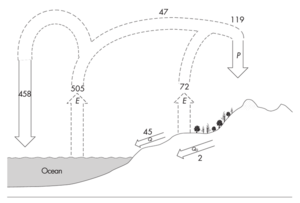Hydrological cycle: различия между версиями
| (не показана 1 промежуточная версия этого же участника) | |||
| Строка 21: | Строка 21: | ||
* '''Evaporation''' of liquid water into water vapour that is moved around the atmosphere. | * '''Evaporation''' of liquid water into water vapour that is moved around the atmosphere. | ||
* '''Precipitation''' (when the vapour condenses into a liquid or solid and falls to the surface) | * '''Precipitation''' (when the vapour condenses into a liquid or solid and falls to the surface) | ||
| − | * '''Runoff''' (which is the difference between evaporation and precipitation in the terrestrial zone), water moving over or under the surface towards the oceans. | + | * '''[[Runoff]]''' (which is the difference between evaporation and precipitation in the terrestrial zone), water moving over or under the surface towards the oceans. |
==Пример использования термина на английском языке== | ==Пример использования термина на английском языке== | ||
| − | Note that with the experimental | + | Note that with the experimental design adopted, only the impacts of climate change on thehydrological cycle are addressed, and not those associatedwith potential land use or water management change.<ref>Dayon G., Boé J., Martin É., Gailhard J. Impacts of climate change on the hydrological cycle over France and associated uncertainties // Comptes Rendus Geoscience. – 2018. – Vol. 350. – № 4. – P. 141-153. </ref> |
==Перевод использования на русском языке== | ==Перевод использования на русском языке== | ||
Текущая версия на 00:21, 22 декабря 2021
Круговорот воды в природе
Непрерывный процесс циркуляции воды на земном шаре, происходящий под влиянием солнечной радиации и силы тяжести.[1]
В общем виде состоит из нескольких глобальных процессов:
- Испарение
- Выпадение осадков
- Поверхностный сток
- Подземный сток
Определение на английском
The hydrological cycle of the earth is the sum total of all processes in which water moves from the land and ocean surface to the atmosphere and back in form of precipitation.[3]
A cycle consists of:
- Evaporation of liquid water into water vapour that is moved around the atmosphere.
- Precipitation (when the vapour condenses into a liquid or solid and falls to the surface)
- Runoff (which is the difference between evaporation and precipitation in the terrestrial zone), water moving over or under the surface towards the oceans.
Пример использования термина на английском языке
Note that with the experimental design adopted, only the impacts of climate change on thehydrological cycle are addressed, and not those associatedwith potential land use or water management change.[4]
Перевод использования на русском языке
Обратите внимание, что при принятой экспериментальной схеме рассматривается только воздействие изменения климата на гидрологический цикл, но не воздействие, связанное с возможными изменениями в землепользовании или управлении водными ресурсами.
Список литературы
- ↑ https://cugms.ru/gidrologiya/slovar-gidrologicheskih-terminov/ Accessed: 2021-12-21
- ↑ Davie T. Fundamentals of Hydrology, Second Edition. Vol. 298. – Oxon: Routledge, 2008. – 200 p.
- ↑ Chakravarty P., Kumar M. Floral Species in Pollution Remediation and Augmentation of Micrometeorological Conditions and Microclimate: An Integrated Approach // Phytomanagement of Polluted Sites: Market Opportunities in Sustainable Phytoremediation. – 2019. – P. 203-219.
- ↑ Dayon G., Boé J., Martin É., Gailhard J. Impacts of climate change on the hydrological cycle over France and associated uncertainties // Comptes Rendus Geoscience. – 2018. – Vol. 350. – № 4. – P. 141-153.
